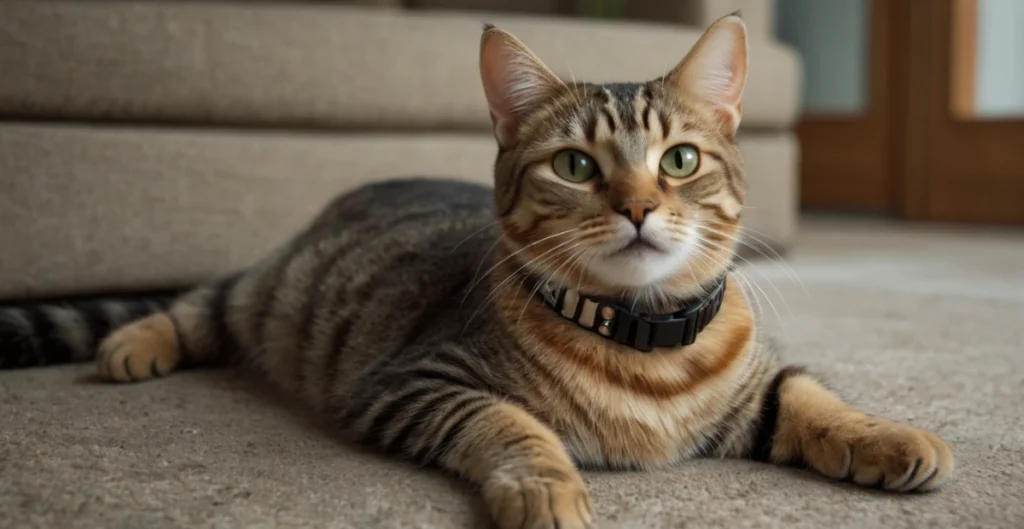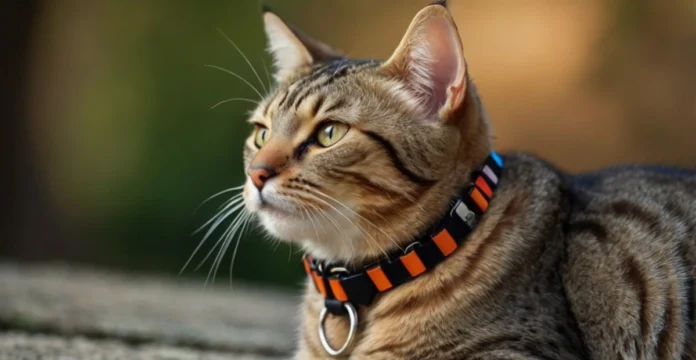Choosing the right collar for your cat isn’t just about style — it’s about safety, comfort, and functionality. As a pet owner, your goal is to ensure your feline friend remains both secure and stylish while wearing a collar. After all, a collar is more than just an accessory; it’s an essential tool for keeping your cat safe and giving you peace of mind. But with so many options available, how do you know which one is best for your furry companion?
advertisement
In this comprehensive guide, we’ll walk you through everything you need to know about choosing the perfect cat collar. From materials to safety features, and from different types of collars to how to properly introduce them to your cat, we’ve got you covered. By the end of this article, you’ll have all the information you need to make an informed decision, ensuring that your cat’s collar is both practical and stylish.
Table of Contents
The Heartwarming Bond Between You and Your Cat

There’s something magical about the bond between you and your cat. Whether they’re curled up next to you on the couch, purring contentedly in your lap, or exploring the great outdoors, your cat’s safety and well-being should always be a top priority. One of the easiest ways to keep them safe is by providing them with a collar that suits their needs.
But it’s not just about safety. Your cat’s collar also serves as a way for them to express their unique personality. Whether they prefer a minimalist design or a bold, colorful statement, their collar can be a reflection of who they are. The right collar not only enhances their look but also serves a practical purpose — keeping them identifiable, visible, and comfortable.
advertisement
Why Does Your Cat Need a Collar?

Safety and Identification
The primary reason for your cat to wear a collar is safety. Collars with ID tags are crucial if your cat goes missing. If your cat has a collar with an engraved tag that includes your contact information, there’s a much higher chance that they will be safely returned to you. Collars can also include other important information, like your cat’s microchip number, especially in the case of an outdoor cat.
If your cat roams outside, a reflective collar can make them more visible at night, reducing the risk of accidents. Think about it — a black cat crossing a dark road at night is practically invisible without proper visibility. A reflective collar ensures that your feline companion can be seen, making it easier for you or others to spot them in low light conditions.
Fashion and Personality
Collars aren’t just functional — they can also be fun! From sparkly rhinestones to simple leather straps, collars offer a great way to express your cat’s personality. You can match the collar to their fur color or choose one that reflects their playful nature. Some owners even opt for personalized collars with their cat’s name or a custom design.
Beyond aesthetics, collars come in various materials, designs, and colors. Whether you prefer something sleek and modern or a bit more whimsical, there’s a collar that fits your cat’s style and your taste.
Key Features to Look for in a Cat Collar
Choosing the right collar involves more than just picking a color. To ensure that the collar fits your cat’s needs, there are several important features you should consider.
advertisement
Material Matters
One of the first things you’ll want to think about is the material of the collar. Cats spend a lot of time grooming, so you want a collar that’s comfortable, durable, and gentle on their skin. Common collar materials include:
- Nylon: Lightweight, durable, and available in many colors and patterns, nylon is a popular option for cat collars. It’s perfect for everyday wear and can withstand the elements.
- Leather: For a more classic, luxurious look, leather collars are a great option. Leather is durable, but be sure to check for softness to avoid irritation.
- Cotton: If your cat has sensitive skin, cotton collars may be a good choice. They are soft and breathable, reducing the chances of skin irritation.
When choosing the material, also consider whether your cat has any allergies or sensitivities. Hypoallergenic options, such as collars made from organic cotton or special blends, are available for cats with sensitive skin.
Breakaway Mechanism for Safety
One of the most important safety features to look for in a cat collar is the breakaway mechanism. This feature allows the collar to break open if it gets caught on something, preventing your cat from choking or injuring themselves. Whether your cat is an indoor or outdoor adventurer, a breakaway collar is essential for their safety.
Breakaway collars are particularly useful for outdoor cats who might get caught on branches, fences, or other objects. The quick-release mechanism ensures that your cat can escape without causing harm, even if they get stuck.
Size and Adjustability
A collar that’s too tight can cause discomfort, while one that’s too loose can easily slip off. That’s why it’s crucial to choose a collar that’s the right size and adjustable. The general rule is that you should be able to fit two fingers between the collar and your cat’s neck for a comfortable fit.
When purchasing a collar, ensure it’s adjustable so that you can make it tighter or looser as needed. Cats grow, and you might need to adjust the collar size to fit their changing neck size. Adjustable collars also allow you to ensure that your cat is comfortable at all times.
advertisement
Types of Cat Collars and Their Uses
Now that you know the key features to look for, let’s explore the different types of cat collars available and how each one serves a different purpose.
Traditional Collars
Traditional collars are simple, adjustable, and come in a variety of materials and colors. These collars are perfect for everyday use and can include features like ID tags or reflective strips for added safety.
- Pros: Lightweight, customizable, widely available.
- Cons: Limited functionality beyond identification and style.
Flea Collars
If your cat spends a lot of time outdoors, flea collars can be a great addition to their grooming routine. These collars release chemicals that help prevent flea and tick infestations, keeping your cat comfortable and healthy.
- Pros: Effective in preventing fleas and ticks, easy to use.
- Cons: Some cats may be sensitive to the chemicals, and the collar needs to be replaced periodically.
GPS Collars
For owners of adventurous outdoor cats, a GPS collar can provide peace of mind. These collars allow you to track your cat’s location using a mobile app. They’re especially useful if your cat tends to roam far from home or has a habit of disappearing for hours at a time.
- Pros: Real-time tracking, peace of mind.
- Cons: Expensive, requires charging or battery replacement.
How to Introduce Your Cat to a New Collar
Introducing a new collar to your cat can be a bit tricky. Some cats may resist wearing one, especially if they’ve never worn a collar before. Here’s how to make the transition as smooth as possible:
Gradual Introduction Techniques
Start by letting your cat sniff and explore the collar before attempting to put it on. Once they seem comfortable with it, gently place the collar around their neck for short periods of time. Gradually increase the time they wear it, offering praise and treats to reinforce positive behavior. This gradual approach will help your cat adjust to wearing the collar without causing stress or discomfort.
Observe and Adjust
advertisement
Once your cat is wearing the collar, keep a close eye on them to ensure that it isn’t causing any issues. Look for signs of irritation, such as scratching or licking at the collar area. If your cat seems uncomfortable, adjust the collar’s tightness or consider switching to a different material.
The Do’s and Don’ts of Choosing a Cat Collar
When choosing a collar for your cat, there are a few do’s and don’ts to keep in mind.
Do’s
- Do choose a lightweight collar: Cats don’t like wearing heavy collars, so opt for a lightweight option that won’t cause discomfort.
- Do ensure the collar is easy to clean: Cats tend to get into mischief, and their collars can get dirty. Choose a collar that’s easy to wash or wipe clean.
- Do use a breakaway collar: For safety, always choose a breakaway collar that will release if it gets caught.
Don’ts
- Don’t use non-breakaway collars: Never use a collar without a breakaway feature, especially if your cat spends time outdoors.
- Don’t choose a collar with sharp edges: Collars with sharp edges or embellishments can cause injury to your cat.
- Don’t buy a collar that’s too tight: A collar that’s too tight can cause pain and even restrict blood flow.
Common Questions About Cat Collars (FAQ)
Can cats wear collars all the time?
Yes, cats can wear collars all the time, but it’s important to check the collar regularly to ensure it’s not too tight and to clean it as needed. You should also occasionally remove the collar to inspect your cat’s neck for signs of irritation.
Are breakaway collars safe for outdoor cats?
advertisement
Yes, breakaway collars are designed to be safe for outdoor cats. The mechanism releases if the collar gets caught, allowing your cat to escape potential dangers. However, always make sure the collar fits properly.
How often should I replace my cat’s collar?
Collars should be replaced every 6–12 months or sooner if they show signs of wear and tear. The breakaway mechanism, in particular, may wear out over time.
Conclusion
Choosing the right collar for your cat is more than just a fashion decision — it’s a matter of safety, comfort, and practicality. Whether you opt for a simple nylon collar with an ID tag or a high-tech GPS collar to track your cat’s movements, the right collar will keep your feline companion safe, stylish, and comfortable.
Remember to prioritize safety features like a breakaway mechanism and ensure the collar is made from materials that suit your cat’s needs. By considering the key features and types of collars, you’ll be able to make an informed decision that benefits both you and your cat.
Are you ready to find the perfect collar for your feline friend? Start by assessing your cat’s needs and preferences, and you’ll find a collar that’s the perfect fit.
Don’t wait — ensure your cat’s safety and style today!

